Introduction
India is a Sovereign Socialist Secular Democratic Republic with a Parliamentary form of government. The government is federal in structure with unitary features. India is the largest democracy in the world.
India has a strong central government elected by citizens. Also, each state of India has its elected governments. The central government has a Council of Ministers headed by the Prime Minister to advise the President. The president is the constitutional head.
In the same way, each state has a Council of Ministers headed by the Chief Minister to advise the Governor. The President appoints the Governor on the advice of the Prime Minister.
This article takes you through the following subtopics:
- Who elects the Prime Minister of India
- Brief on the Constitution of India
- President of India
- Vice-President of India
- Office of the Prime Minister of India
- Council of ministers
- Indian Parliament
- Upper House or Rajya Sabha
- Lower House or Lok Sabha
- Lok Sabha Speaker
- And a few frequently asked questions.
Who elects the Prime Minister of India?
The Prime Minister of India is not directly elected in an election. The Election Commission of India (ECI) administers and oversees the parliamentary (Lok Sabha) elections. Once the results are declared, the ECI constitutes the new Lok Sabha by notifying the Official Gazette. The Gazette notification includes the names of the elected members and their political affiliations.
Each political party or group in the Lok Sabha elects its leader. The leader of the political party who enjoys the majority support in Lok Sabha will meet the President to state a claim to form the Government.
The present Lok Sabha has a strength of 543 elected Members of Parliament (MP). So, the leader of a political party/group with the support of 273 or more MPs (more than 50%) can stake the claim to form the government.
The President verifies the claim submitted by the majority leader of the Lok Sabha. Consequently, the president appoints him/her as the Prime Minister and invites to form the Government.
To summarize, firstly the MPs of the majority party or group elect their leader. Secondly, the President, after due verification, will appoint the leader of the majority party/group as the Prime Minister.
During the parliamentary election for the Lok Sabha, a political party/group can fight the election by projecting their Prime Minister candidate. Alternatively, they may say that their leader will be elected after the election.
The Prime Minister has to be a member of either Lok Sabha or Rajya Sabha at the time of appointment. If not, he/she should become a member within a maximum period of six months.
There is no restriction on the number of terms a person can hold the office of the Prime Minister of India.
We shall discuss more about the office of the Prime Minister during this article.
Brief on the Constitution of India
The Constitution of India declares India a Sovereign, Socialist, Secular Democratic Republic.
Article I of the Constitution explains India as a ‘Union of States’ and states can exercise the power given to it by the constitution. However, the states do not have the freedom to separate themselves from the Union. This is for maintaining the unity and integrity of the country.
Each state has a governor appointed by the central government. The state chief minister (CM) is the leader of the majority party. The CM has the support of more than 50% of the elected members of the State Legislative Assembly.
The chief minister and his/her council of ministers exercise the powers given to the states by the Constitution. The bills passed by a state assembly will not become law unless approved by the governor.
President of India
Unlike countries like the United States, the President of India is more of a ceremonial post. The executive power is in the hands of the Prime Minister and Council of Ministers.
The President of India is a constitutional executive head and is indirectly elected. Articles 54 and 55 of the Constitution deal with the election of the President of India.
Article 54 deals with the Electoral College for the indirect election of the President, and the proportional representation. Article 55 deals with ensuring uniformity in the votes of Members of Parliament and Members of State Legislatures and other issues in the presidential election.
The qualifications for holding the office of president are:
- Should be a citizen of India
- Completed the age of 35 years
- Have all the qualifications for becoming a member of the Lok Sabha
- Not holding an office of profit in a state or central government
- He/she should not be a member of Lok Sabha, Rajya Sabha, or State Legislature.
The Electoral College for the indirect election of the President of India consists of the elected members of the houses of Parliament of India, and the elected members of the States and Union Territories Legislative Assemblies. However, the nominated members of the three houses are not eligible to vote. The election of the President of India is conducted by the Election Commission of India.
The President of India can be removed from office by impeachment. The resolution of the impeachment can be initiated by either house of parliament (Lok Sabha or Rajya Sabha). The impeachment can be passed after due investigation and requires a minimum of 2/3 majority support.
There is no restriction on the number of terms a person can hold the office of the President. However, there is only one president, Dr. Rajendra Prasad, who had more than one term as president.
Unlike in the USA, in the event of the death of a serving president, the vice-president will not automatically assume the position of president. Instead, the vice-president assumes the position of acting president and looks after the functions of the president till a new president is elected and assumes office.
Even though the President of India is considered a ceremonial post, the post assumes importance in times of crisis. Especially when there is a hung parliament and no single party enjoys majority support.
In such circumstances, the president can play a crucial and positive role in installing a majority government. The president does this by taking the help and advice of eminent personalities and constitutional experts.
Any bill passed by the Indian Parliament cannot become law unless it is signed by the President of India.
A list of Presidents of India (former and present) is compiled and displayed in the image below.
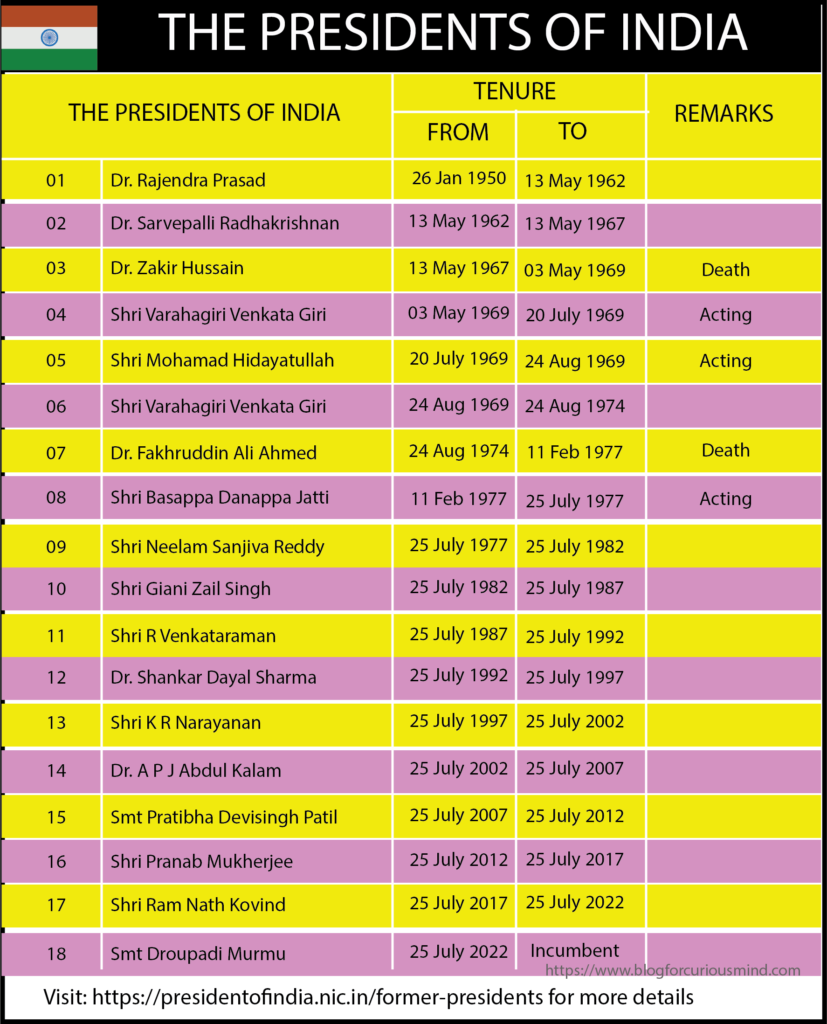
Vice-president of India
Article 63 of the Constitution provides for the office of vice-president of India. The intention is similar to the constitution of the United States. That is, to take care of the office of the President in case of exigencies.
However, unlike in the US, in the event of the death of a sitting president, the vice-president will not assume the position of the president. Instead, the vice-president assumes the position of acting president and discharges the duties till a new president is elected.
The qualifications for holding the office of vice president are:
- Should be a citizen of India
- Completed the age of 35 years
- Should have all the qualifications for becoming a member of the Rajya Sabha
- Not holding an office of profit in a state or central (he/she must resign the office in the event of getting elected as vice-president)
- He/she should not be a member of Lok Sabha, Rajya Sabha, or State Legislature.
The vice president of India is elected by the members of Lok Sabha and Rajya Sabha. The system of proportional representation by way of a single transferable vote is followed. The vice-president is elected for five years and he/she can seek re-election.
When the office of the vice president falls vacant due to death or resignation, the position is filled by holding the election within 6 months of the vacancy. The new incumbent will have a complete five-year term.
The vice-president can be removed from office by passing a resolution by the members of the Rajya Sabha and acceptance by the Lok Sabha.
The vice president has two functions:
- As vice president step into the role of president during an exigency
- As the chairman of the Rajya Sabha.
A list of Vice presidents of India (former and present) is compiled and displayed in the image below.
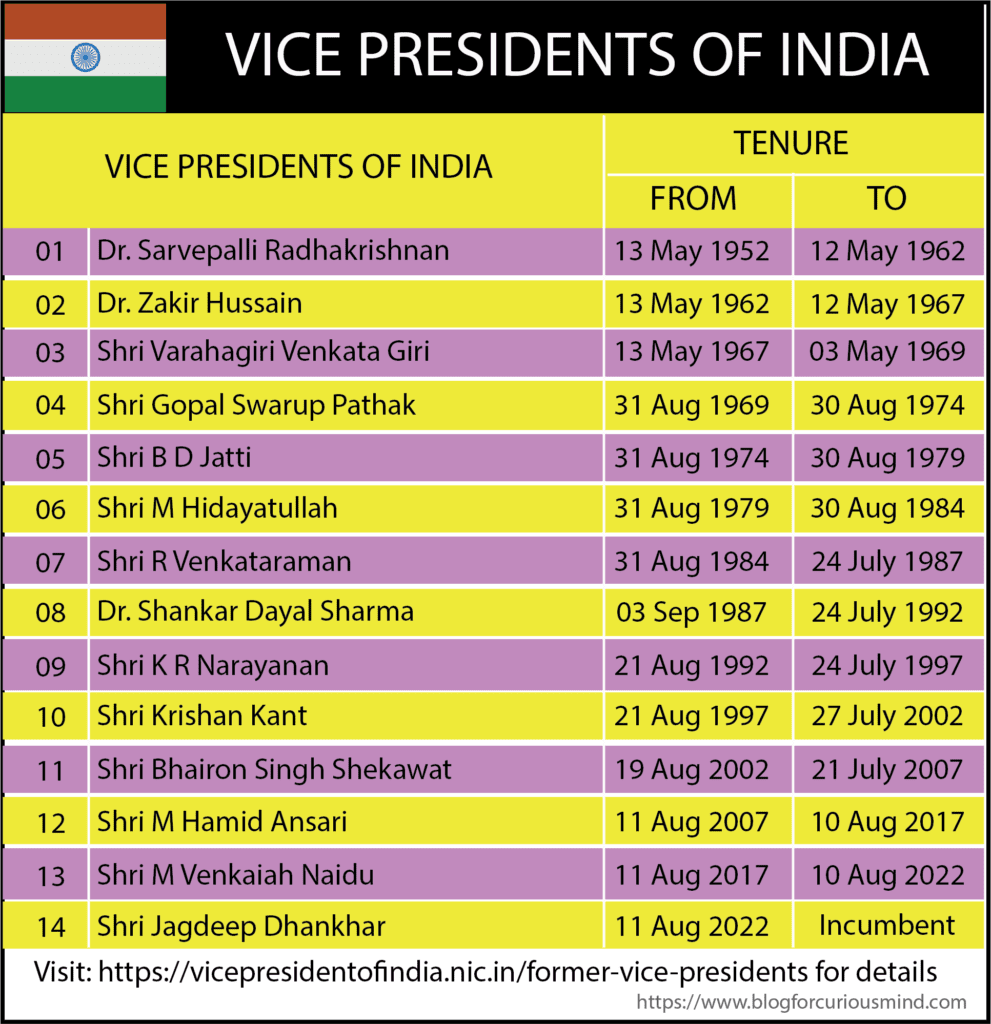
Office of the Prime Minister of India
The Prime Minister is the leader of the majority party in the Lok Sabha. But he/she can be a member of the Lok Sabha, or Rajya Sabha. The prime minister enjoys the majority support in Lok Sabha.
The office of the Prime Minister is the most powerful in the Indian political system. The Prime Minister is the strongest person in the central cabinet of ministers. In the Indian political system, the position of the Prime Minister is comparable with the President in the US political system.
The Prime Minister is the head of the Government of India and the guardian of the executive authority.
As per the constitution, the President appoints the Prime Minister. However, the President is duty-bound to appoint the leader of the majority party or group in the Lok Sabha as the Prime Minister. When doing so, the President can verify the claim of the majority leader before appointing him/her as the Prime Minister.
However, in a hung parliament, no single political party or group has the required numbers. Under such circumstances, the President may consult experts, and make a decision to invite the leader of a political party or group that has the support of the highest number of parliament members to form the government. The invitee should prove the majority support within a specified period.
The Prime Minister holds the office at the pleasure of the President. This implies that as long as he/she enjoys the support and confidence of the majority in the Lok Sabha. The Lok Sabha can pass a no-confidence motion to compel the Prime Minister to resign or get dismissed by the President.
The Prime Minister may lose the majority support in the Lok Sabha due to a split in the political party or taking back support by one or more groups. Then the President can direct the Prime Minister to prove the majority on the floor. Failure to prove the majority ends up in the resignation or dismissal of the Prime Minister.
The power and functions of the Prime Minister are not formally described in the Constitution. However, as the head of the Council of Ministers, and the head of the Cabinet Ministers, the prime Minister is the leader of the majority party in the parliament and leader of the nation. All these make the office of the Prime Minister the most powerful position in the political system of India. The Prime Minister is behind all the fiscal policies and economic planning introduced by the Government.
The Prime Minister derives strength from his/her popularity among the people of India. A strong Prime Minister is a charismatic leader who wins the hearts of the people through his/her acts and policies.
Examples of such charismatic Prime Ministers are Pandit Jawaharlal Nehru, Smt. Indira Gandhi, and the present Prime Minister Shri Narendra Modi. A charismatic Prime Minister can win elections fought under his or her name.
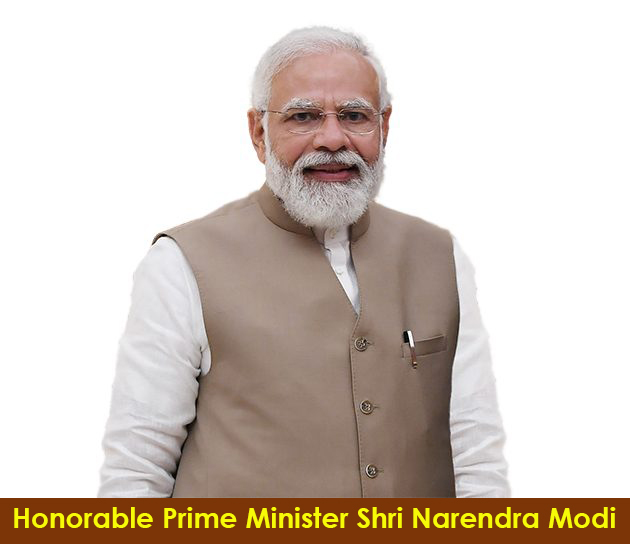
The personality of the Prime Minister and the love and respect he/she commands from the people is a source of strength for him/her, and his/her party. Charismatic prime Ministers like Pandit Jawaharlal Nehru, Smt Indira Gandhi, and the present Prime Minister Shri Narendra Modi won the hearts of the people due to their bold actions and have won elections for their party.
A strong prime Minister plays a leadership role at the national and international level and leads the country both in times of peace and war. The influence a Prime Minister wields and the love he/she commands among the people of India is the real source of authority. Hence, the role played by the Prime Minister at the national and international level greatly depends on the personality of the person who holds the office.
A list of Prime Ministers of India (former and present) is compiled and displayed in the image below.
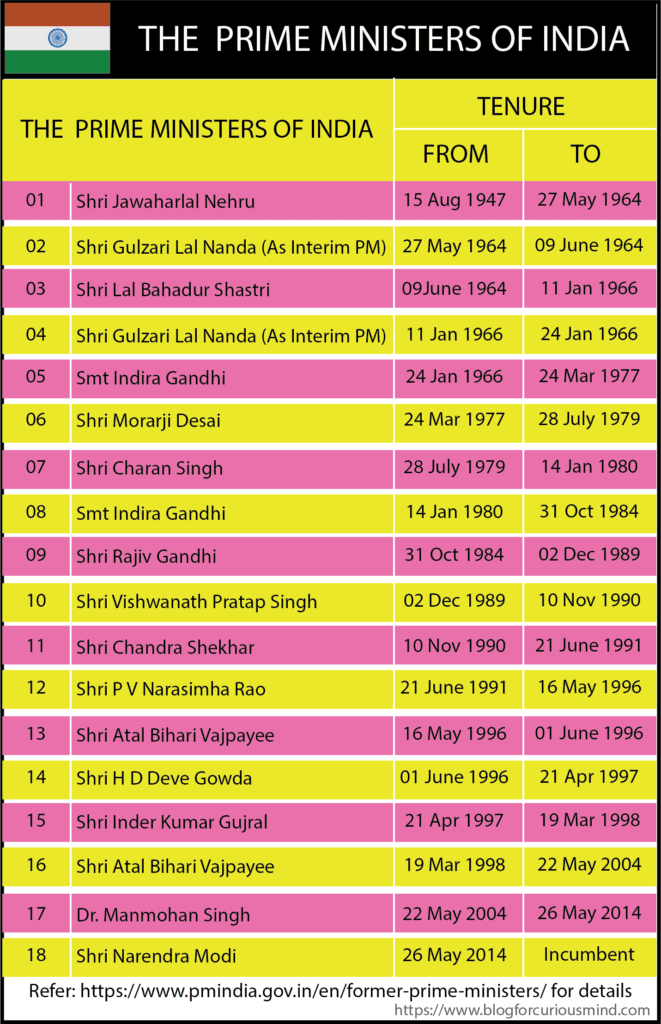
Council of ministers
The formation of the Union Council of Ministers starts with the President appointing the Prime Minister. Subsequently, the president appoints the Council of Ministers on the recommendation of the Prime Minister. As per Article 75(3) of the constitution, the council of ministers shall be collectively responsible to the Lok Sabha (the house of the people).
The Constitution of India allows for a parliamentary system of government and the executive is divided into two parts. The first part is the President, the Constitutional executive. And the second part, the Council of Ministers headed by the Prime Minister is the real executive.
Article 74 of the Constitution amply explains the real executive. It reads “There shall be a Council of Ministers with the Prime Minister as the head, to aid and advice the president, who shall in the exercise of his functions, act in accordance with such advice“.
While forming the Council of Ministers, the Prime Minister ensures due representation to different states, regions, and communities in his/her own party,. The Prime Minister selects qualified and experienced persons for specialized ministries like finance, external affairs, etc.
The maximum strength of the council of ministers should be within 15% of the strength of the Lok Sabha and the minister has to be a member of either of the two houses. The Council of Ministers can be of the rank of Cabinet Minister or Minister of State.
As per Article 75 of the Constitution, a minister in the council holds the office at the pleasure of the President. It actually implies that they hold the office as long as they enjoy the confidence of the majority in the Lok Sabha or the confidence of the Prime Minister. The Prime Minister can seek the resignation of any minister at any time, and normally the minister complies with the request.
The tenure of the council of ministers or the prime minister is for the term of the Lok Sabha or as long as they have the majority support in the Lok Sabha, whichever happens, earlier.
Indian parliament
Like the legislatures of major democracies, the Indian parliament is bicameral. It has two houses, the Lok Sabha, or the House of the People is the lower house. And the Rajya Sabha or the Council of States is the upper house. The Indian parliament comprises the President and two houses of parliament.
The Lok Sabha is directly elected by the eligible voters of India and is the popular and powerful lower house. The Rajya Sabha is indirectly elected upper house.
Unlike the British Parliament, the Indian Parliament does not have sovereign status. The laws enacted by it have to be in conformity with the provisions of the Indian Constitution. The laws enacted by the Indian Parliament can be questioned by a citizen in the Supreme Court of India. The Supreme Court may declare the law unconstitutional if the law is not in conformity with the Constitution.
The Union Parliament is a powerful institution in the Indian political system and has the power to impeach the President of India, the Judges of the Supreme Court of India, and the High Courts of India.
Upper House or Rajya Sabha
The maximum strength of the Rajya Sabha is 250. Out of these 12 members are nominated members. These 12 members are nominated by the President and are persons of eminence who have achieved distinctions in their field of service.
The remaining members represent different states and are elected by the members of the State Legislative Assemblies. The number of members elected by each state assembly differs on the state’s population. A state with a higher population has more seats.
Unlike the Lok Sabha, the Rajya Sabha is a quasi-permanent house. And it is not subject to dissolution. The tenure of a Rajya Sabha member is 6 years. One-third of the Rajya Sabha members retire after every alternate year and the vacant seats are filled by elections.
The President normally convenes Rajya Sabha sessions along with Lok Sabha, but the gap between the two sessions cannot be more than six months. Under exceptional circumstances, like when the Lok Sabha is under dissolution, the President can call only the Rajya Sabha session for emergency needs.
The required qualifications for a member of the Rajya Sabha are:
- He/she must be a citizen of India
- Must be more than 30 years of age
- Qualifications as laid down by parliament
- Should not be holding any office of profit in a state or central government
- Not disqualified under any law of parliament.
The Vice President of India is the ex-officio Chairman of the Rajya Sabha and presides over the upper house.
Lower House or Lok Sabha
The Lok Sabha is the house of the people and is the lower house of the union parliament. It represents the people of India and is a highly powerful house. When the constitution was inaugurated on 26th January 1950, the strength of the Lok Sabha members was fixed at 500. However, with different amendments, the present strength of the Lok Sabha is fixed at 545, including two nominated members.
Parliamentary elections in India
The Election Commission of India (ECI) conducts the parliamentary/Lok Sabha elections. After the conclusion of elections and the declaration of results, the ECI constitutes the new Lok Sabha. It does it by notifying the names of the elected members and their political affiliations in the Official Gazette.
The members of the Lok Sabha are directly elected by the people of India. A citizen of India who has attained 18 or more years has the right to vote in all elections. He/she can vote from the place of registration as a voter.
The country is divided into territorial constituencies and each constituency elects a member to the Lok Sabha. The voters listed in each constituency vote for the candidate of their choice.
Each voter can cast his/her vote in favor of the candidate of his/her choice. A candidate securing the maximum number of votes (among the contesting candidates) is declared elected as a member of Lok Sabha or a Member of Parliament.
Some constituencies are reserved for certain categories of people (scheduled caste, scheduled tribe, etc.) and such constituencies can be represented only by a person belonging to that category.
The normal term of a Lok Sabha is five years and this can be extended by one year during an emergency. The President, on the advice of the Prime Minister (Council of Ministers), can dissolve the Lok Sabha before the expiry of its five-year term and order fresh elections. They are called midterm elections.
The President can call the session of the Lok Sabha at any time, but the gap between two such sessions should not exceed six months.
The eligibility for contesting for a member of Lok Sabha is:
- He/she should be a citizen of India and should have attained 25 years or more age
- Not holding any office of profit under the state or central government
- Should have sound mental health
- Should not be a bankrupt
- Not declared as an offender of a serious crime by a court of law
The Lok Sabha, being directly elected by the electorate, is more powerful than the Rajya Sabha. Like the House of Commons of the United Kingdom, the Lok Sabha is the center of power in the Indian Parliament.
A list containing state-wise and union territory-wise seats in the Lok Sabha is compiled and displayed in the image below.
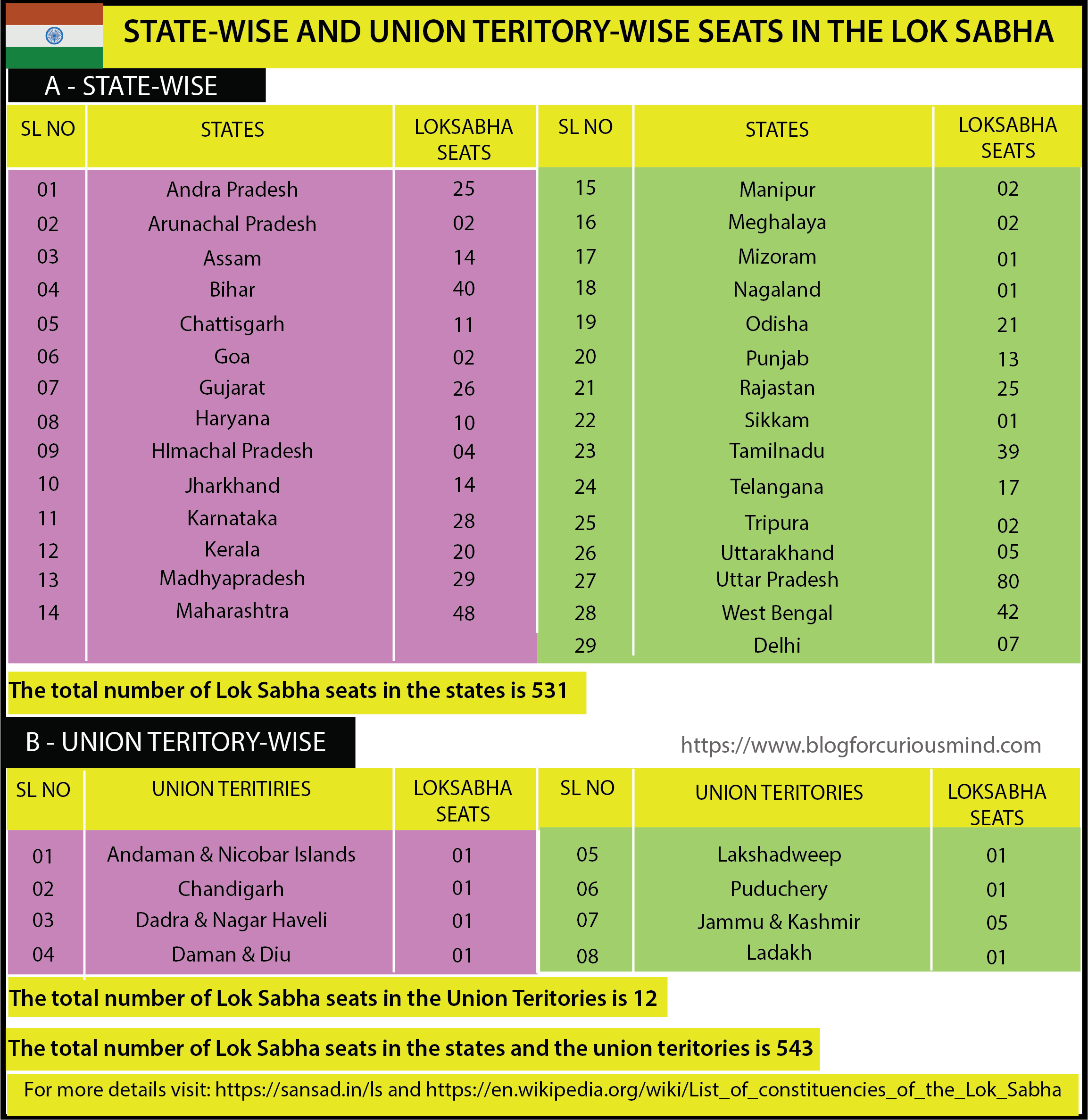
Lok sabha speaker
The members of Lok Sabha elect a speaker and deputy speaker from amongst themselves. The office of the Lok Sabha speaker carries great dignity and the speaker is the most powerful person in the Lok Sabha. The Lok Sabha speaker enjoys a status equivalent to the Chief Justice of India.
Even though the speaker belongs to a political party, he/she is expected to act neutral and impartial during the transactions of Lok Sabha business. The speaker maintains the dignity of their office by being neutral and impartial most of the time.
As in the case of the British House of Commons and the US House of Representatives, the speaker elected by the Lok Sabha presides over the lower house.
A list of Lok Sabha Speakers (former and present) is compiled and displayed in the image below.

Frequently Asked Questions (FAQ)
Is it necessary for the Prime Minister to be a member of the Lok Sabha?
There was an unwritten convention that the Prime Minister should be a member of Lok Sabha. However, this convention was broken many times. As of now, the Prime Minister can be a member of either house of parliament.
If the Prime Minister is not a member of Lok Sabha or Rajya Sabha at the time of appointment, he/she should become a member of either house within six months.
What is a coalition government?
The results of a Lok Sabha election can throw a hung Lok Sabha. A coalition of like-minded parties can be the only way out to form a stable government. A hung Lok Sabha is a situation where no single party has the majority to cross the halfway mark. For a simple majority, a political party/group must have the support of more than 50% of the members.
In the case of a hung Lok Sabha, like-minded parties can come together based on a common minimum program and stake their claim for the formation of the government. Such a group is called a coalition.
The President examines the claim and after due discussions with his/her advisors, and satisfied completely, invites the coalition leader to form the government. The President may direct the coalition leader to prove the majority support on the floor of the Lok Sabha within the stipulated period.
Who presides over a joint session of Lok Sabha and Rajya Sabha?
The joint sitting of the Lok Sabha and the Rajya Sabha is presided over by the speaker of the Lok Sabha.
What is the Election Commission of India? What are its functions?
The Election Commission of India (ECI) is an autonomous constitutional authority. It is responsible for administering the election processes at both the central and state levels in India. The ECI functions under the authority of the Constitution, as per Article 324, and subsequently enacted ‘the Representation of the People Act’.
The constitution of India has vested or bestowed in the Election Commission of India the superintendence, direction, and control of the entire process for conducting the elections to parliament, state legislative assemblies of every state, the President of India, and the Vice-President of India in the country. The ECI also conducts other elections related to the Rajya Sabha, state legislative councils, and local governments through its state-level offices.
The ECI is a permanent independent constitutional authority established in agreement with the constitution on 25th January 1950. Initially, the ECI had only one Chief Election Commissioner, but, presently the ECI consists of the Chief Election Commissioner and two Election Commissioners.
The two additional Election Commissioners were appointed for the first time on 16th October 1989, but they had a short tenure till 1st January 1990. However, two additional Election Commissioners were appointed on 1st October 1993, and since then the ECI has Chief Election Commissioner and two Election Commissioners.
Whenever there is a disagreement between the Chief Election Commissioner and Election Commissioners, the matter is decided by majority vote. The Chief Election Commissioner and the Election Commissioners enjoy the status of a Judge of the Supreme Court of India. The Chief Election Commissioner can be removed from office only by impeachment procedure.
The ECI has the responsibility of conducting free and fair elections in India at the central and state levels. This includes preparing, maintaining, and periodic updates of Electoral Rolls. ECI also supervises the nomination of contesting candidates, registration of political parties, and monitoring of funding and expenditures made by the candidates during an election. The ECI supervises the complete election process from the date of declaration of elections till the counting of votes and declaration of results.
The ECI, most of the time makes the consensus decision, but in case of disagreement, the majority view prevails.
The ECI is headquartered in New Delhi with a Secretariat and has a Chief Electoral Officer with supporting staff in the capital of every state. The ECI and Chief Electoral Officers work on a full-time basis.
The ECI and the Chief Electoral Officers have enormous administrative powers during the election process. With valid justification they can direct transfer or placement of officers at various levels of Police and Administration as required for conducting the elections in a free and fair manner. The ECI can request Central Para Military Forces to maintain peace in sensitive places during elections.
What is an Electronic Voting Machine (EVM)?
Electronic Voting Machines or EVMs are developed for facilitating simple polling and easy counting of votes. EVMs also save the printing and paper costs and time spent in manual counting.
The EVMS is developed by Electronics Corporation of India Limited (ECIL) and Bharat Electronics Limited (BEL). The EVMs provide a complete safeguard for maintaining the secrecy of voting, non-tempering of the voting data, and enabling faster announcement of election results.
A necessary amendment of the Representation of People Act, 1951, was done by the Parliament to enable the Election Commission of India to deploy or adopt the EVMs in election constituencies. The ECI demonstrated the use and effectiveness of the EVMs in the presence of registered political parties. The ECI has also issued guidelines for using EVMs transparently and unambiguously.
An EVM is made of two units (i) a control unit and (ii) a balloting unit and they are connected through a cable. The control unit is placed at the polling officer and the balloting unit is placed in the enclosed polling chamber for voters to cast their votes.
This enables the polling officer to verify the identity of the voter. The polling officer does not issue a ballot paper to the voter, instead, he/she will press the Ballot Button to enable the voter to cast a vote.
A complete list of candidates and their voting symbols are displayed for the voter to make his/her selection. The voter can press the button against the candidate of his/her choice to cast the vote.
Since 2013 a new feature VVPAT (Voter Verifiable Audit Trail) has been added to the EVM. A printer is attached to the EVM in the voting chamber. This printer prints the serial number, name, and symbol of the candidate to whom the voter has voted, and this slip is visible to the voter through a transparent window for a few seconds before it gets cut and falls automatically into a sealed box.
Conclusion
In the preceding paragraphs, we discussed in detail how the Prime Minister of India is elected or appointed and the parliamentary system of governance in India. Hope this article was able to answer most of your questions.
References
‘Indian Constitution’ by Shri S K Ghai, Kalyani Publishers, third revised edition 2006
https://en.wikipedia.org/wiki/List_of_constituencies_of_the_Lok_Sabha
https://presidentofindia.nic.in/former-presidents
https://vicepresidentofindia.nic.in/former-vice-presidents
https://www.pmindia.gov.in/en/former-prime-ministers/
https://speakerloksabha.nic.in/frmspeaker.asp
https://en.wikipedia.org/wiki/Elections_in_India
https://mea.gov.in/Uploads/PublicationDocs/19167_State_wise_seats_in_Lok_Sabha_18-03-2009.pdf https://eci.gov.in/evm/

